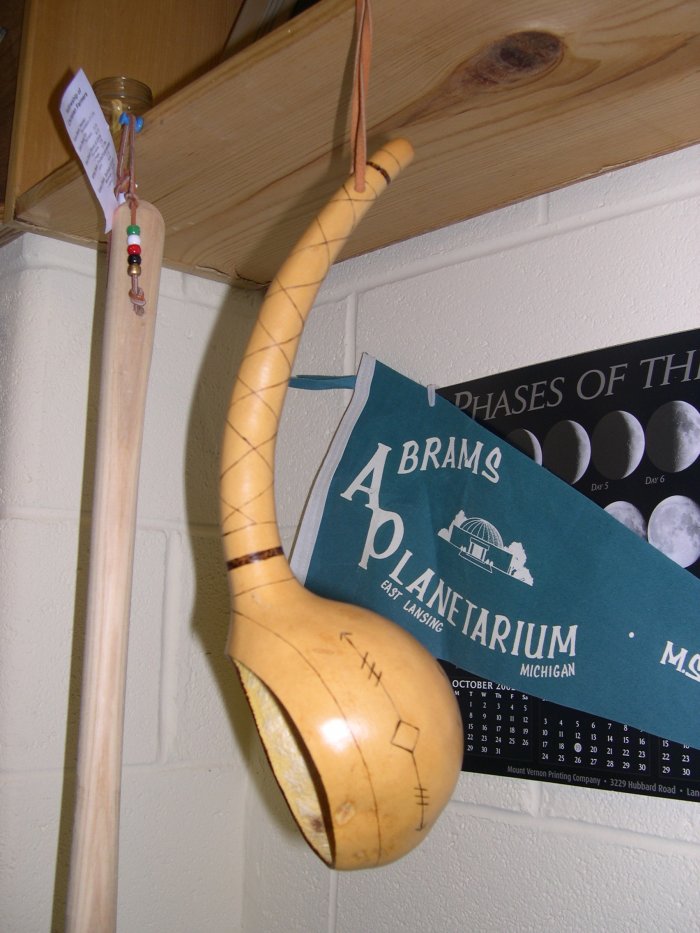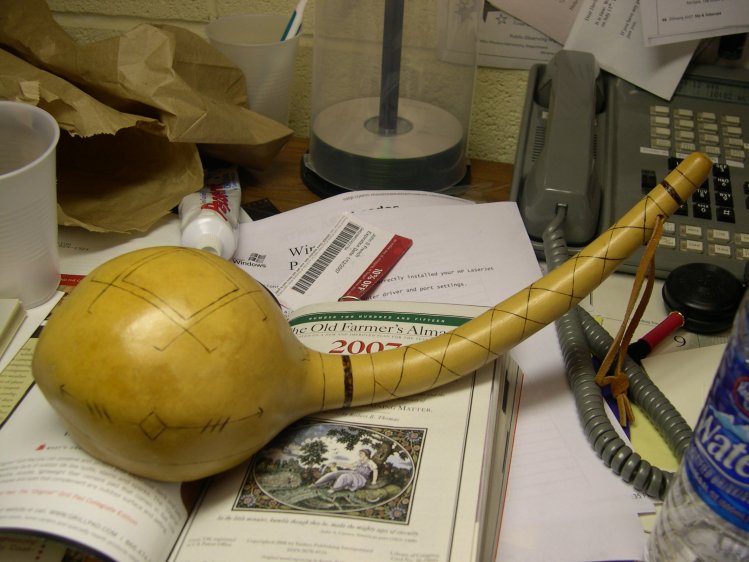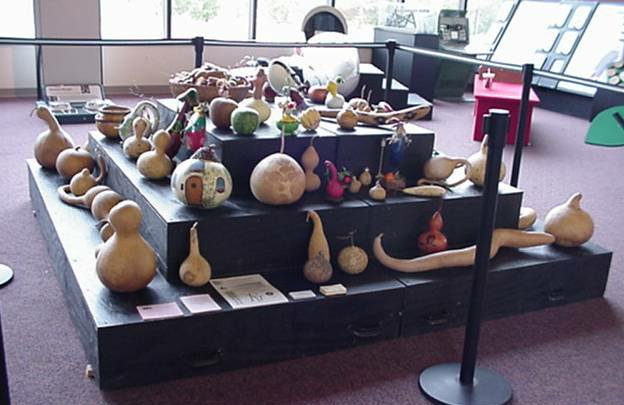|
|
Dipper Gourd
Created by Norma Maynes from the Texas Gourd Society





Gourd display from the Texas Gourd Society at the Cook Center, Corsicana, Texas.




|
Growing Tips From the North Carolina Gourd Society.
Growing gourds is very like growing squash--with some important differences. The biggest difference is that with squash and pumpkins, you harvest at a much earlier stage. Most gardeners have had the experience of finding a giant zucchini that had hidden itself away until it was a giant--tough, stringy and not very good to eat. But with gourds, tough is good. What gives trouble to most new growers, and even some veterans of the gourd patch, is knowing when to harvest and how to cure. Let's start with what all gourds have in common. Then we'll talk about differences in how the various types grow.
Soil preparation-- Like squash, gourds like light, well-drained soil, but will settle for less. In Carolina red clay, a raised bed can help, because the soil warms sooner in the spring. A soil test will show whether you need to lime or make nutritional additions. Gourds like a pH range of 5.8-6.2.
Gourd enemies-- Gourds don't like weeds or drought. Diseases like bacterial wilt, anthracnose and mildew strike gourds. You can control by cleanliness and eliminating disease carriers--like cucumber beetles, carriers of bacterial wilt.
Pollination--Each gourd vine bears male and female flowers.The male flowers appear first. You can tell the difference because female flowers have a small gourd shape beneath petals. The first vine that grows will have more male flowers than female. Cut the vine at about 10 feet long to get more female flowers--and more gourds. Insects (and industrious gourd gardeners) carry pollen from male to female flowers. Bees have been the most frequent pollinators, but bee mites have cut local populations. Don't kill any more by using the insecticide, Sevin, on blossoms, because it is hardest on bees. Other insects, even enemies like cucumber beetles and squash bugs, are frequent pollinators as well. The more pollinations, the more fruit and the more seed. Pollen can be gently transferred with an artists' paintbrush or a cotton swab or by picking the male flower and carrying pollen to the female. Generally, the largely the gourd, the fewer you'll get per vine: one bushel and 100 bananas, for example.
Growing Hardshell Gourds
Hardshells mature in 110-130 days, so plant as soon as the soil warms in the spring. In the North Carolina Piedmont, late April through mid-June is good. Follow recommendations for planting winter squash. Too early, and your seed can rot. Too late, and the gourd will not be mature at frost.
Hardshell gourd seed are generally a heavy, ridged, shield shape. Gourds of recent African origin, like basketballs, have a black seed shaped like watermelon seed. Soaking overnight can speed germination. Starting seed indoors in peat pots can also lengthen the growing season, but gourd roots are deep and wide, so give the seedlings room. All gourds sprawl. A hardshell can grow a 100-foot-long vine in a single season. Most growers recommend spacing in hills 6 feet apart in rows at least 4 feet apart. One Guinness Book of Records gardener plants a single dipper in a 10'x10'square. Plant 4-6 seeds about twice the length of the seed. Keep moist. Seed typically germinate in 8-10 days, but can sprout as long as six weeks after planting. Most early growth is underground, so don't despair if you don't see much happening the first month or so. Black fabric mulch keeps weeds down in the expanses between the hills and raises soil temperature.
To trellis, or not to trellis is the question in the gourd patch. Trellised gourds are cleaner and easier to protect from insects. Gourd vines don't have to be trained. They climb as naturally as monkeys. Two sturdy posts, an upper and lower wire and garden twine woven between will support heavy gourds, like birdhouses. An oversized wire cage, like a tomato cage, but larger, works for smaller gourds, like bananas. The key is how heavy the gourds are. Several dozen 10-pound bottles gets to be a strain. Your trellis can crash. A single 200-pound bushel is impossible. Your trellis will crash. Another question is what you plan to do with your gourd. Young gourds are soft and pliable. Grown on the ground, the increasing weight of the gourd causes the shape to settle so the gourd has a flat side to sit on. A trellis-grown gourd will roll around on a round bottom.
On the ground, gourd vines root at the joints, providing extra nutrition and insurance against vine borers. Slip a shingle, brick or bit of new wood (old wood brings termites) underneath and dust every few days with Sevin.
Growers have widely, make that wildly, different ideas about fertilizing hardshells. Some think none is best, other fertilize daily with manure tea. I sprinkle a handful of 10-10-10 in a circle around the hill when planting, so the roots will reach it when growth is well established. Everybody agrees that fertilizing after August encourages leaf growth when the gourd should be hardening.
Few pests bother hardshells. Snails and cucumber beetle larvae can kill seedlings. Adult cucumber beetles chew holes in leaves, but more important, carry bacterial wilt. Squash bugs are often abundant. Vine borers don't seem to bother hardshells.
"My gourds rotted" is a common complaint from new growers. The remedy is harvest when the gourd is mature. When the vine beginsto turn brown where it meets the gourd, cut the vine two or three inches from the gourd. You can wash with either chlorine bleach or borax solutions. Handle gourds gently to prevent bruising, and put in a warm, airy place. Freezing won't hurt a mature gourd, and you might as well get rid of others sooner rather than later. Winters where the temperature dives below freezing and stays there may hurt viability of the seed, but Carolina winters may actually increase viability. When the seeds rattle, the gourd is ready to use.
Growing Luffa
Luffa, the sponge gourd, benefits greatly from trellising. Grown on the ground the sponge inside is often discolored and weakened. The trellis must be sturdy to support the heavy gourds. On trellises, space luffa 2'-4' apart. Luffas need at least 110 days to mature, so plant as soon as the soil warms up, late April in North Carolina. Pay particular attention to controlling insects when the little luffas first start growing. Terry Holdsclaw, whose generous sharing of his experience is the source of this information, says luffa vines will tell you when they need fertilizer. He says, "Healthy, mature leaves have a metallic bluish tint to them. If the leaves lose this tint, they need to be fertilized." An application eight weeks after planting prevents loss of color.
When the skin turns brown or yellow, pick. You can easily peel at this stage, although many growers wait until the luffa is totally dry and brown. Shake out the seeds, and bleach the interior with chlorine bleach if you like.
Growing Ornamental Gourds
Ornamentals are just as easy to grow as zucchinis. Ornamental seed look like summer squash seed although different kinds can have different size seeds. They germinate well without soaking. Ornamentals mature in about 90 days from planting, so count backwards from when you want them to choose a planting time. In the Carolina Piedmont, a late April to early May planting will produce a crop by Independence Day, and you can celebrate by planting more for fall harvest. Plant hills about 4 feet apart in rows four feet apart. Plant three seeds to the hill, about half an inch deep. Thin to two. If you are planting from a pack marked "mixed," leave seedlings of various sizes. Different sizes often show different kinds.Growers rarely trellis ornamentals. Because they are small and light, there is no need to keep them from settling into the soil.
Fertilizing ornamentals sparks little controversy. Work about a quarter cup of 10-10-10 in a ring around the hill at planting. You can work another quarter cup of fertilizer in around the roots about 30 days after planting.
During the growing season, your main job is fighting bugs. Ornamentals suffer more damage than hardshells. Aphids (watch for ants), cucumber beetles, slugs and squash bugs eat ornamentals. Worst of all are squash vine borers. By the time, you know they're there, your gourd vine isn't. Encourage root growth at joints, and use Thiodan or Sevin on the vine near the hill.
Harvesting at the right time is the first key to curing ornamentals. Pick too soon and the gourds rot. Pick too late and sunshine fades the bright colors. Now comes the secret: Test for maturity by gently squeezing the gourd. Start at the end of the vine where the baby gourds are, and work your way back to the hill where the most mature are. If you avoid arrest for baby gourd molesting or other forms of insanity, you'll eventually begin to notice a point where the gourd is harder. It is more shell than flesh inside. Cut it from the vine. Curing is the gradual movement of water from inside to outside. Don't seal ornamentals. Varnishing or shellacking, as many vendors do, seals in water and dooms the gourd to rot. Polish with liquid floor wax if desired.
|